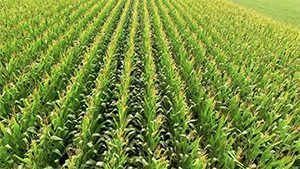Where Does Short-Season Corn Fit?

This article written by Dr. Reynold Bergen, BCRC Science Director, originally appeared in the May 2020 issue of Canadian Cattlemen magazine and is reprinted on the BCRC Blog with permission of the publisher.
Statistics Canada reports that Western Canada’s silage corn acreage has grown significantly in recent years. Nearly 30% of seeded corn silage acres aren’t harvested, suggesting it’s likely being used for grazing. The potential for a 50% higher yield compared to barley may offset corn’s 30% higher input costs, but only if growing conditions are right.
It is critically important to pick a hybrid that can grow under local conditions. A hybrid with a higher corn heat unit (CHU) rating than local conditions provide will not have time to reach optimal maturity before it is harvested or frozen, and will contain more fiber, more moisture, fewer cobs and less starch than ideal. It will also be less palatable and nutritious, whether it’s harvested for silage or left for grazing. On the other hand, a short season hybrid grown in a historically hot area would be ready to harvest before the growing season is over, sacrificing some potential yield. Corn silage that is harvested too late will be too dry, making it harder to pack and reducing silage palatability. Not every year is ‘average’, and year-to-year variations in growing conditions also need to be considered before deciding whether to try corn, or which hybrid to try.
Agriculture and Agri-Food Canada’s Karen Beauchemin and Vern Baron recently published a Beef Cluster study examining short season corn hybrids grown in different CHU zones in Western Canada (Corn Forage Yield and Quality for Silage in Short Growing Season Areas of the Canadian Prairies, doi:10.3390/agronomy8090164).
What They Did:
Short- to medium-season corn hybrids were grown in 2013, 2014 and 2015 at Lacombe, Lethbridge and Vauxhall (Alberta) and Elm Creek (Manitoba), sites that have considerably different growing conditions. Five or six different hybrids were chosen for each site based on their suitability for the long-term average CHU during the growing season at that site. Hybrids with CHU ratings between 2000 and 2200 were grown in Lacombe (long-term average of 2025 CHU during the growing season). Hybrids with CHU ratings of 2000 to 2600 were grown in Lethbridge (long-term average of 2135 CHU). Hybrids with CHU ratings between 2200 and 2600 were grown in Vauxhall (long-term average 2161 CHU). Hybrids with CHU ratings between 2175 and 2650 were grown in Elm Creek (long-term average 2590 CHU). Most hybrids were only grown at one, two or three sites; only one was grown at all four sites. Plots were generally seeded in mid-May and harvested in mid- to late September, just before the first frost. The Lethbridge and Vauxhall sites were irrigated, and all plots were fertilized generously to ensure that hybrid maturity and climate were the only factors limiting corn growth. Temperature and moisture (precipitation and irrigation) data were collected, and corn yield and nutritional value were measured.
While new hybrids have become available in the five years since this research was completed, the key findings and principles haven’t changed.
What They Learned:
Lacombe received 26% to 39% less rainfall than average in all three years. Actual CHU during the growing season only reached the long-term average in 2013, when plot yields averaged 23 US (short) tons of wet silage per acre. Yields were lower in the cooler years (10 to 11 tons per acre). Only the lowest CHU hybrid achieved the minimum dry matter (30%), starch (20%) and cob (50%) percentages required for adequate silage quality, but it also had the lowest yield.
In Lethbridge, actual CHUs exceeded the long-term average every year, but yields varied from 8.2 to 20 tons per acre in spite of irrigation. All hybrids met minimum silage quality parameters.
In Vauxhall, actual CHUs exceeded the long-term average every year and yields were relatively stable (15 to 20 tons per acre), but the two hybrids with the highest CHU rating failed to meet minimum silage quality parameters.
Elm Creek received 24 to 40% less rainfall than average each year. Actual CHUs were below the long-term average every year, but average yields remained reasonably stable (16 tons to 20 tons per acre). The two hybrids with the highest CHU ratings failed to achieve minimum silage quality parameters.
Corn needs heat, and it needs it at the right time. The period between silking and harvest (when cobs and kernels are developing and filling) is particularly important. At each site, yields were always lower in the year(s) when actual CHUs from silking to harvest were low.
What it Means:
The growing season is too short and variable in many areas to reliably grow short- to medium-season hybrids for silage or grazing. Corn can be a risky choice, especially in regions where long-term average CHUs during the growing season are close to the minimum CHU rating of the available hybrids.
There are trade-offs between yield and quality. Hybrids with the highest CHU ratings often yield better but generally have lower nutritional value. Whether animal performance will be impacted (e.g. feedlot growth rate and feed conversion, or body weight and condition score of breeding stock grazing corn) will depend on the hybrid, year-to-year growing conditions, and other nutritional management factors.
The Beef Research Cluster is funded by the Canadian Beef Cattle Check-Off and Agriculture and Agri-Food Canada with additional contributions from provincial beef industry groups and governments to advance research and technology transfer supporting the Canadian beef industry’s vision to be recognized as a preferred supplier of healthy, high quality beef, cattle and genetics.
Click here to subscribe to the BCRC Blog and receive email notifications when new content is posted.
The sharing or reprinting of BCRC Blog articles is typically welcome and encouraged, however this article requires permission of the original publisher.
We welcome your questions, comments and suggestions. Contact us directly or generate public discussion by posting your thoughts below.